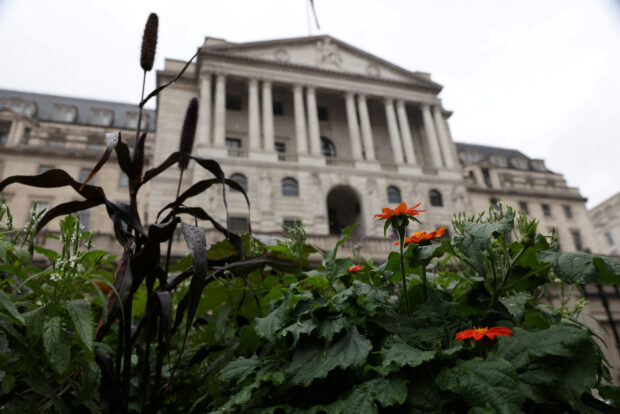
Flowers grow outside the Bank of England in the City of London, Britain, July 30, 2023. REUTERS/Hollie Adams/File photo
LONDON – The Bank of England raised its key interest rate by a quarter of a percentage point to a 15-year peak of 5.25 percent on Thursday, and gave a new warning that borrowing costs were likely to stay high for some time.
Unlike the U.S. Federal Reserve or the European Central Bank – which also both raised rates by a quarter-point last week – the BoE’s Monetary Policy Committee gave little suggestion that rate hikes were about to end as it battles high inflation.
“The MPC will ensure that Bank Rate is sufficiently restrictive for sufficiently long to return inflation to the 2-percent target,” the BoE said in new guidance about the outlook for rates.
“Some of the risks of more persistent inflationary pressures may have begun to crystallize,” it added.
British inflation hit a 41-year high of 11.1 percent last year and has fallen more slowly than elsewhere, dropping to 7.9 percent in June, the highest of any major economy.
Economists polled by Reuters last week forecast BoE rates would peak at 5.75 percent later this year. The BoE’s own forecasts were based on recent market assumptions – which have now eased somewhat – that rates would peak at over 6 percent and average nearly 5.5 percent over the next three years.
“Inflation hits the least well-off hardest and we need to make absolutely sure that it falls all the way back to the 2 percent target,” Governor Andrew Bailey said.
Three-way split
Policymakers voted 6-3 for the increase, but were split three ways on the decision for the first time this year. Two MPC members – Catherine Mann and Jonathan Haskel – voted for a half-point increase this month, while Swati Dhingra voted for no change, as she has all this year, warning of overtightening.
Markets had seen a roughly one-in-three chance of a bigger increase to 5.5percent, which would have repeated June’s outsize rise.
The BoE forecast inflation would fall to 4.9 percent by the end of this year – a faster decline than it had predicted in May.
This will relieve Prime Minister Rishi Sunak, who pledged in January to halve inflation this year, a goal which had looked challenging.
However, the BoE forecasts inflation will be slightly slower to fall from late next year. Inflation does not return to its 2 percent target until the second quarter of 2025, three months later than it forecast in May.
The BoE said it was incorporating more of the upside risks to inflation which the MPC saw in May into its central or “modal” forecast, despite a bigger-than-expected fall in inflation in June.
Services price inflation – which the BoE said offered a signal on longer-term price trends – was projected to stay high, and wage growth at the end of this year was expected to be 6 percent, up from May’s forecast of 5 percent.
Wage rises had been a bigger driver of high inflation than companies’ profit margins, the BoE said.
The BoE, which noted the economy’s recent “surprising resilience”, changed its growth forecasts little from three months ago, with the economy due to expand a meagre 0.5 percent in 2023 and 2024, and just 0.25 percent in 2025.
The jobless rate is predicted to rise to 4.8 percent by late 2024, up from a forecast of 4.4 percent in May and 4 percent in the latest data.
Mortgage costs have hit their highest since 2008, weighing on house-building. The BoE forecast housing investment would fall 5.75 percent this year and 6.25 percent in 2024.